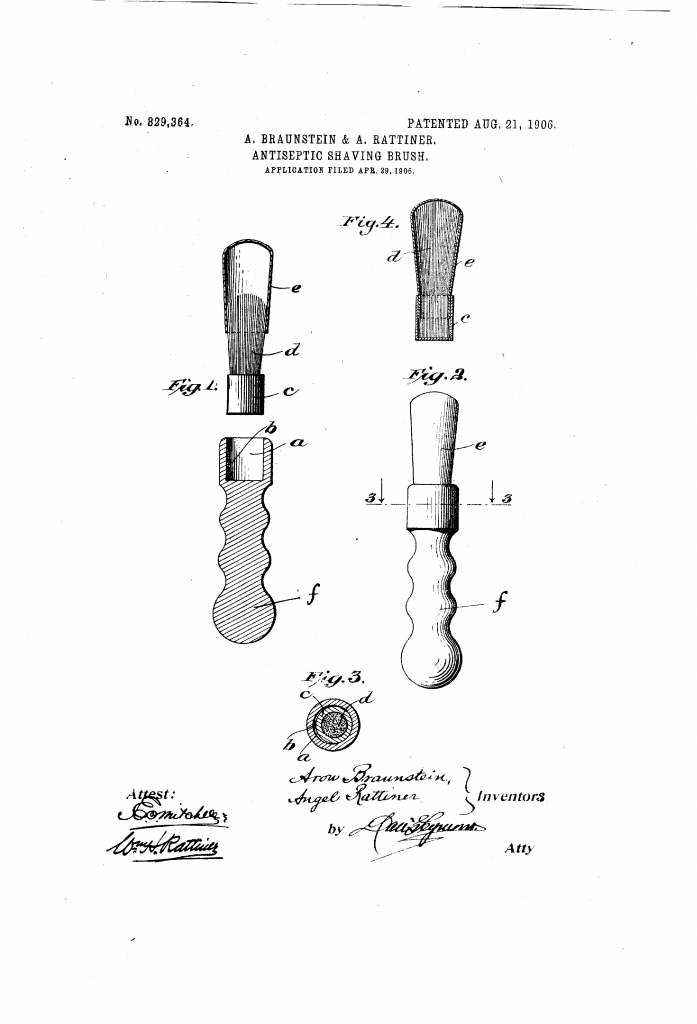Antiseptic – like hygienic, sanitary, aseptic, and disposable – is a word that keeps popping up in patent descriptions of shaving gear. This seem to have been especially prevalent in the first half of the last century, before the discovery of penicillin and other effective antibiotics made a cut or a nick more of a nuisance than a real threat to life and health. Today’s patent for an antiseptic shaving brush was filed by Aron Braunstein and Angel Rattiner back in early 1905.
As so often is the case, they did claim that their patent was a new and useful improvement upon the state of the art. Specifically they had come up with a way to make sure the brush was only used once, that the brush was pre-impregnated with an antiseptic soap, and that it was antiseptic up to the point of being used. In the words of the patent:
The object of our invention is to provide a shaving-brush with a brush portion or member which can be used but once and being impregnated with an antiseptic soap or similar solution will in itself provide the soap for lather.
From US patent 329,364
A further object of our invention is to pro wide means for keeping said brush member antiseptic at all times before being used and after once being used it cannot be used again without the fact of such use being indicated to the subsequent user.
This they did by making the the brush in two parts. A reusable handle, and a disposable knot.
The handle had a socket on the end to hold the knot. In the socket there was a flat spring, which helped hold the knot in place. And that is really all the patent has to say on the handle.
The knot were to be made of bristles, hair, or other suitable fibre. The knot was held together with band or cap of paper or a similar material that would soften when wet. The whole thing would, after being impregnated with an antiseptic soap, be covered by a paper casing or envelope.
The patent suggest that the knot with cap and envelope would be supplied as a ‘cartridge’, and that a number of them would be supplied with each handle.

To use, the barber would insert the knot cartridge into the handle, before tearing or cutting the envelope away. He would then apply water, make lather, and shave in the normal way. The water would, as the shave progressed, soften the paper cap or band holding the knot together. Thus when the barber removed the knot from the handle, it would fall apart.
The customer could see that a new knot was being used, by the fact that the envelope was still on the knot. And reuse was made impossible, since the know would not be able to be reinserted in the handle.
All in all there is no reason why this antiseptic shaving brush wouldn’t work as intended. But the bottom has kind of fallen out of the marked. Not only do we have effective antibiotics, such as barbercide1, but we also have shaving brushes made out of materials that can be sterilised.
Oh, and the traditional barbershop is more or less gone. There is much less fear of accidental infection when you shave yourself at home – even if there may be more nicks and cuts.
The full patent for Braunstein’s and Rattiner’s antiseptic shaving brush can be read at Google Patents.
- Which, if the name is to be taken seriously, kills barbers. ↩︎

Pingback: Antiseptic shaving brush - Razors n Blades the shave that saves
Pingback: Schmidt's shaving brush container - Wegian WetshavingWegian Wetshaving
Pingback: A brush with a notch, with soap cup and lathering bowl - Wegian WetshavingWegian Wetshaving